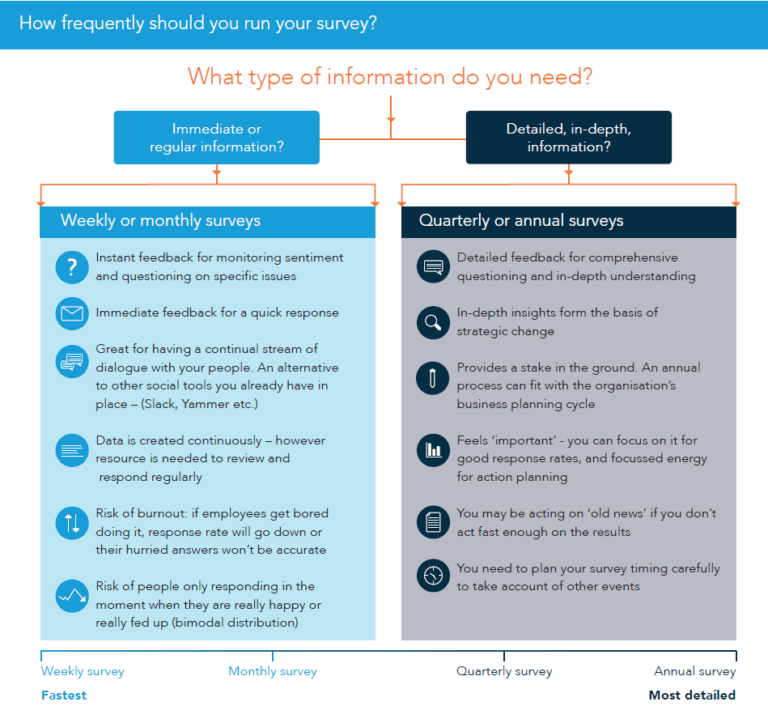
Survey fatigue is a growing concern among managers and leaders within organisations which is, of course, understandable. Employee surveys are a great employee listening tool, allowing us to create actionable plans to improve employee engagement and morale in a meaningful way. But is it possible to have too much of a good thing?
Let’s explore the concept of survey fatigue – what is it exactly and how can you avoid it? In this blog post, we’ll explore this phenomenon and offer practical advice on how to keep your surveys effective and your employees excited about sharing their thoughts and insights.
Read further: How to choose an employee survey provider
Survey fatigue is when employees become overwhelmed, frustrated and disengaged with the frequency and length of staff surveys they are asked to complete. This survey fatigue can lead to lower response rates, incomplete answers and a general decline in the quality of feedback received.
HR managers often worry that they are running the risk of over surveying their staff, and rightly so. When employees feel bombarded with surveys, they may start to perceive them as a chore and a box-ticking exercise, rather than an opportunity to share valuable insights. This can result in disengagement not just from the surveys themselves, but from the company culture and initiatives that rely on this feedback.
This is a tricky question with an annoying answer – it depends. The reality is, no two organisations are the same and, as such, there is no clearcut, staple answer. What we can tell you is that there are surveys that are carried out infrequently, and there are surveys that are carried out on a more regular basis. Both have their advantages, and many businesses choose to use both in conjunction with one another. Done correctly, you can carry out both of these surveys without survey fatigue setting in.

Quarterly and annual surveys are great for collecting in-depth, detailed information. These surveys allow organisations to track long-term trends, measure the impact of major initiatives and gather comprehensive feedback on various aspects of the workplace. Due to their detailed nature, you should keep these surveys less frequent to avoid overwhelming employees. We usually recommend asking 35 questions for these types of surveys.
Pulse surveys, on the other hand, can be carried out more frequently. These are short, focused surveys (around five to 15 questions) that provide immediate or regular information and help maintain a continual stream of dialogue between employees and management. Employee pulse surveys can be administered monthly, bi-monthly or even weekly, depending on the organisation’s needs and the nature of the information being sought.
As we mentioned, each business is unique, so the best way to survey, and how often, will depend on your organisation. It’s important to find a balance that suits your specific environment and needs. Consider factors such as the current level of employee engagement, the importance of timely feedback for ongoing projects and the capacity of your team to respond to and act on survey results.
At People Insight, we like to say that employee engagement is about the active change, not the passive listening. The ultimate goal of conducting surveys isn’t only to collect data. It’s to enact meaningful change based on the feedback received. Surveys should be a tool for active change and meaningful organisational improvement. When you fail to act, time and again, your employees become disillusioned and they begin to believe that nothing will ever change. And if that’s the case, why bother speaking up? It’s this apathy in the face of inaction that is the true cause of survey fatigue, not the frequency of the surveys themselves.
The reality is, employees are generally disbelieving that action will be taken – and we have data to back this up. According to our most recent data, across sectors, only 47% employees believe action will be taken following a survey. This is, of course, the major issue. Employees should only be asked for their opinions if there is a genuine desire to use those opinions to spark real change within your organisation.
Employees need to feel that their voices are heard and taken into consideration. This means not only acknowledging the feedback received but also communicating how this feedback will be used to make changes. It’s crucial to demonstrate that surveys are not just a formality, but a step towards real change. This can be achieved by:
When employees see that their feedback leads to meaningful change, they’ll be more excited and eager to participate in future surveys. This helps maintain high engagement levels and ensures that the surveys continue to provide valuable insights.
Survey fatigue is a real challenge that can undermine the effectiveness of your employee feedback initiatives. By understanding what survey fatigue is and how to avoid it, you can ensure that your surveys remain a valuable tool for improving your organisation.
Are you looking to carry out actionable surveys? People Insight are leaders in the employee survey field. We carry out the survey, you benefit from our intuitive platform and our employee experience experts will work with you to enact meaningful change based on your company’s unique results. Get in touch today to get started.

